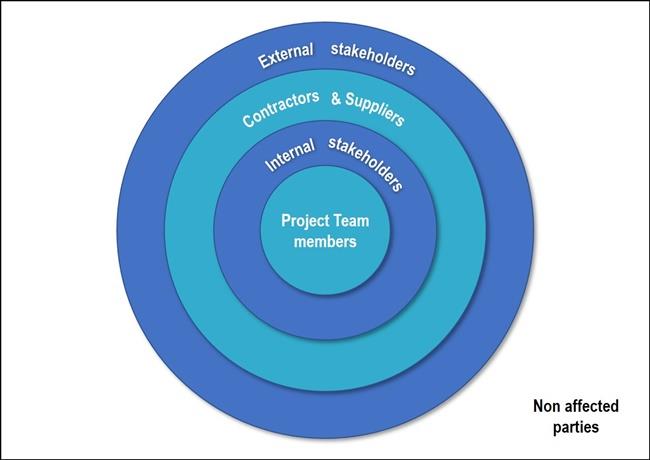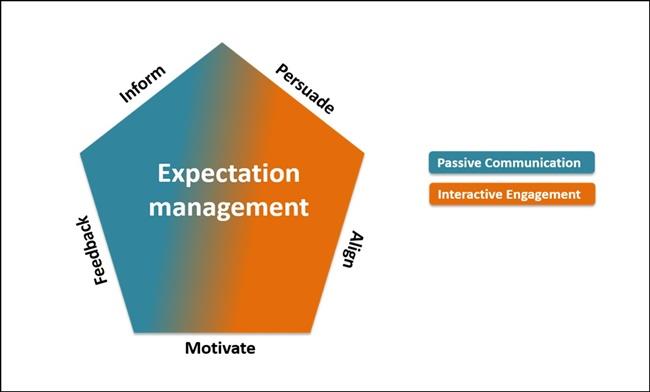Construction of process plants (“Project”) extend over long period of time and require large capital. Due to large investment and complexities of the Project, the project developers (“Company”) requires participation and support from other organisations, including financing agencies. Such wide participation brings knowledge to the Project through all stakeholders. To harness the energy of stakeholders, there is a need to engage with all stakeholders with a systematic approach. Such engagement can be in a group, in formal or informal environment. Since stakeholders have interest in success of the Project, the Company must make consistent efforts to identify stakeholder interest by understanding their perspective and work on the feedback. This may secure the support of stakeholder for the decision making and may improve the success rate.
There are two types of stakeholders-internal and external. Internal stakeholder may include financing agency, internal customer, and employees. The external stakeholders are technology supplier, competitors, and local communities. Cooperation of all the stakeholders is very important to the Project as any disagreement between the stakeholders can cause delay to completion of the Project.
Stakeholder management is the process required to identify the people, groups, or organizations that could impact or be impacted by the Project. This requires analysis of stakeholder expectations to develop appropriate management strategies for effective engagement of stakeholders in the Project decision making. A collaborative approach between the stakeholder and the Company is essential for success of the Project.

Type of Stakeholders
The Company is required to manage following categories of stakeholders in the Project:
Internal
- Company Directors and top management
- Project team
- Financing agencies
- Internal customer
- Employees
External:
- Government agencies
- External customer
- Technology suppliers
- Contractors, subcontractor, and vendors
- Local communities and NGO
- Media
Impact of each of the above stakeholder is briefly described below.
Company Directors and top management
This group of stakeholder controls finances and all major decisions on the Project. Company Directors are leading the Project and therefore their impact is highest on the Project. Company Directors are supported by top management in decision making. Top management group includes financial, human resources and legal teams.
Project team
This includes all persons working on the Project such as technical, purchasing, commercial human resources and any other function supporting the Project directly or indirectly, whether part-time or full time. The actions of this group of stakeholder impacts directly.
Financing agency
The financing agency is one of the most important stakeholders as this group has big influence in decision making and selection of technology and contracting conditions. Financing agencies come on board from the concept stage of the Project and influence critical decisions.
Contractors, subcontractors, and Vendors
These are the persons who are directly associated in execution of the Project such as technology licensors, engineering contractors, design engineers, vendors, inspection, expediting and logistics team members. This will also include technical consultants, business advisors, financial and legal advisors who provide support to the Project on-call.
Government agencies
This includes environment protection agency, local authorities and all regularity authorities providing permits and statutory inspections. Their actions have significant impact on the Project.
Local communities and NGOs
Even though local communities and non-government organisations do not financially support the Project but the impact of the Project on their daily lives is very significant. Local communities and NGOs will not be supportive of any Project which has adverse impact on the environment.
Topics of interest to Stakeholders.
Common topics which interest stakeholders in the Project are:
Project data and progress
All stakeholders require information regarding cost of the Project, product information, cost-benefit analysis, implementation time schedule and progress of the Project. The stakeholder may also like to know any changes to these elements which may affect the outcome.
Social Impact
Most of the stakeholders will be interested in the data relating to the social impact of the Project. Project which use green technology, recycling waste or are friendly to the environment will be appreciated. Projects which cause water and air pollution will not be appreciated in a densely populated area.
Health and Safety
Employees prefer working environment which does not affect their health and safety and provide environment which has no risk of injury. Most employees prefer to work in an environment where they are respected and contributes to their mental well-being. The stakeholders who are visitors to the Project will show concern if they are exposed to an environment which may have risk of health and safety.
Influence of Stakeholder
All the Stakeholders do not have same influence in decision making and therefore the outcome of engagement with each is different for the Project. The principal types of influencers are described below.
High influence with high interest
Financing Agencies and the Company Directors who have controlling interest in the Project are good examples of this category. Due to the power, they have over the Project, it is important to continuously engage with them.
Low interest with High influence
Regulatory and Local Authorities are in this category. It is important to comply with their requirement for success of the Project.
High interest with low influence
Employees and local community leaders are in this category. This group is most affected by the success or the failure of the Project but have no control over the decision-making process.
Low interest with low influence
This includes common persons who may some have some information on the Project but have little interest in its progress.
Stakeholder management plan
Identify stakeholder:
At the commencement of the Project, it is necessary to prepare a list of stakeholders and their level of interest in the Project. Where the importance is high, a meeting with stakeholder may be important. Meeting should be based on the agenda relevant to the Project and the outcome should be documented. The meeting may help to define the level of influence the stakeholder may have on the Project and the subject matter which interests the stakeholder. When in doubt about the level of influence, place the stakeholder in a higher category, to start with.
Communication plan:
An effective communication with each stakeholder is key to the favourable outcome. Based on the level of influence of the stakeholder, one or more methods of communication can be used with stakeholder. Some of the stakeholder may be satisfied with periodic status report while others may ask for detailed report on topics of their interest. Once the format, topic and frequency of communication are defined, the final step is to define the contact point within the Project Team for each stakeholder. When feasible, develop RASCI matrix for stakeholder management.
Feedback
Once the information has been provided to stakeholder, a person-to-person contact can be made with stakeholder who may have strong relation with the Project and can influence the outcome. The contact can be formal or informal. During the interaction, views of the stakeholder should be carefully noted. When the stakeholders are provided sufficient information, and person-to-person contacts enables them to get clarifications which they may need, it is possible that some of the stakeholders may provide feedback which may help to improve the execution methodology and help remove the constrains. Such contact can also be used to seek support of the stakeholder for specific tasks with Regulatory Authorities or Contractors and Vendors, where the stakeholder may have influence.
The feedback obtained during interaction can be analysed and acted upon to the extent the Project plan can accommodate it. Where action has been taken, the outcome of the action must be reported to the stakeholder. Such action will motivate the stakeholder in providing input to the Project in future.
Best practice:
Transparent and timely communication with stakeholder is key to success of the Project. When the communication covers all the topics of interest to stakeholder, it is most likely that the Project will get the support it deserves.

Summary
For a successful Project, it is important that the Project Team develops a strategy to engage with the stakeholder to improve the Project delivery. Most important aspect of the engagement is providing information and continuous updates to the stakeholder. This helps the stakeholder to appreciate the working environment and provide feedback. The feedback received should be used to improve the execution methodology. A two-way communication once established will help the Project.
References:
- Stakeholder management, your guide to influencing project outcome, Mary Pratt & Moira Alexander, January 2024.
- Importance of Project Stakeholder Management, Davida van der Walt, July 2020.

